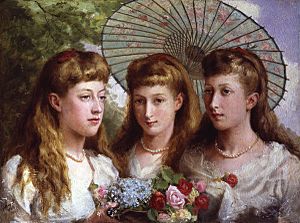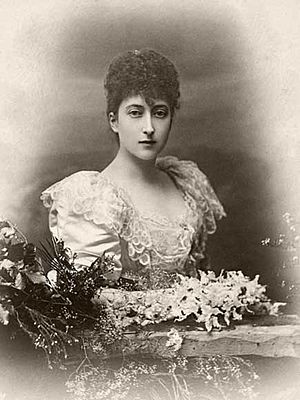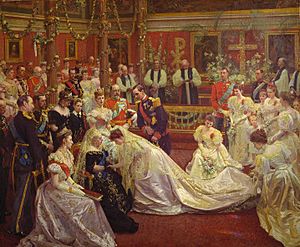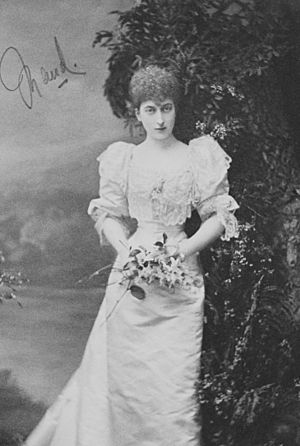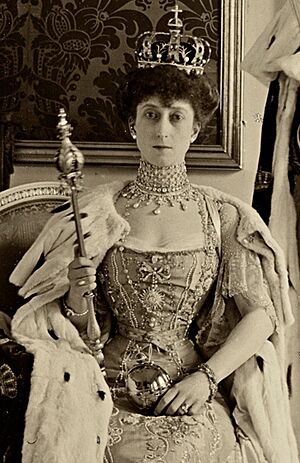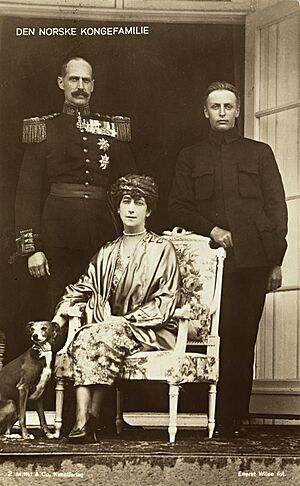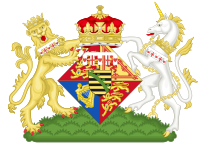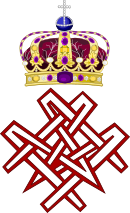Maud of Wales facts for kids
Quick facts for kids Maud of Wales |
|||||
|---|---|---|---|---|---|

Photograph, c. 1910
|
|||||
| Queen consort of Norway | |||||
| Tenure | 18 November 1905 – 20 November 1938 | ||||
| Coronation | 22 June 1906 | ||||
| Born | Princess Maud of Wales 26 November 1869 Marlborough House, London, England |
||||
| Died | 20 November 1938 (aged 68) Marylebone, London, England |
||||
| Burial | 8 December 1938 Akershus Castle, Oslo, Norway |
||||
| Spouse | |||||
| Issue | Olav V of Norway | ||||
|
|||||
| House | Saxe-Coburg and Gotha | ||||
| Father | Edward VII | ||||
| Mother | Alexandra of Denmark | ||||
| Signature |  |
||||
Maud of Wales (born Maud Charlotte Mary Victoria; 26 November 1869 – 20 November 1938) was the Queen of Norway. She was married to King Haakon VII. Maud was the youngest daughter of King Edward VII and Queen Alexandra of the United Kingdom. Before she got married, she was known as Princess Maud of Wales. This was because her father was the Prince of Wales at that time.
Contents
Growing Up as Princess Maud
Maud was born on 26 November 1869 in London, at Marlborough House. She was the fifth child and third daughter of Albert Edward, Prince of Wales, and Alexandra, Princess of Wales. Her father, Albert Edward, was the oldest son of Queen Victoria. Her mother, Alexandra, was the oldest daughter of Christian IX of Denmark.
Maud was christened "Maud Charlotte Mary Victoria" on 24 December 1869. The ceremony took place at Marlborough House.
The royal family called Maud "Harry" because she was a bit of a tomboy. This nickname came from Admiral Henry Keppel, a friend of her father. He was known for being very brave during the Crimean War.
Maud often joined her mother and sisters on trips. They visited her mother's family in Denmark every year. They also went on cruises to Norway and the Mediterranean Sea.
Maud was a bridesmaid at two important royal weddings. In 1885, she was a bridesmaid for her aunt, Princess Beatrice. In 1893, she was a bridesmaid for her brother, George, when he married Mary of Teck.
Maud and her sisters, Victoria and Louise, received special honors. Their grandmother, Queen Victoria, gave them the Imperial Order of the Crown of India in 1887. Maud also held the Royal Order of Victoria and Albert (First Class). She was also a Dame Grand Cross of the Order of the Hospital of St. John of Jerusalem.
Becoming a Princess of Denmark
Princess Maud married later than many princesses of her time. She was in her late twenties when she found a husband.
On 22 July 1896, Princess Maud married her first cousin, Prince Carl of Denmark. Their wedding took place in a private chapel at Buckingham Palace. Prince Carl was the second son of Queen Alexandra's older brother, Crown Prince Frederick of Denmark. His mother was Princess Louise of Sweden.
Maud's father gave them Appleton House as a wedding gift. This country home was on the Sandringham Estate in England. It was a place for Maud to stay during her frequent visits to England. Their only child, Prince Alexander, was born there on 2 July 1903.
Prince Carl was an officer in the Royal Danish Navy. He and his family lived mostly in Denmark until 1905.
Becoming Queen of Norway
In June 1905, something big happened in Norway. The Norwegian parliament, called the Storting, ended Norway's union with Sweden. This union had lasted for 91 years. The Storting then decided to offer the throne of Norway to Prince Carl of Denmark.
Maud's connection to the British royal family was one reason Carl was chosen. After a public vote in November, Prince Carl accepted the throne. He became King Haakon VII of Norway. His young son, Prince Alexander, was renamed Olav.
King Haakon VII and Queen Maud had their coronation on 22 June 1906. This special ceremony took place at Nidaros Cathedral in Trondheim. It was the last coronation ever held in Scandinavia.
Life as Queen of Norway
Queen Maud always loved Britain, but she quickly learned to adapt to her new country. She also took on her duties as Queen of Norway. A royal court was set up for her. Marie Magdalena Rustad became her main lady-in-waiting.
Maud was a strong leader within her court and family. However, she preferred to stay out of the public eye.
In her early years in Norway, Maud and her husband were often photographed. They wore traditional Norwegian folk costumes. They also enjoyed winter sports like skiing. This helped them look more Norwegian to the public.
She did not enjoy formal events much, but she performed her role as queen with great care. She used her clothes and jewelry to look regal and impressive.
Queen Maud supported many good causes. She was especially interested in charities for children and animals. She also encouraged musicians and artists. During World War I, she started "Dronningens Hjelpekomité" (the Queen's Relief Committee).
She supported a home for single mothers in 1906, which was a very modern idea at the time. She also designed furniture for a Children's Exhibition in 1921. She even sold her own photographs to raise money for charity.
Maud loved horseback riding. She made sure the stables at the royal palace in Oslo were improved. She oversaw much of this project herself. She was inspired by the Royal Mews in London when the stables were expanded.
Queen Maud continued to think of Great Britain as her real home. She visited Britain every year. During these visits, she usually stayed at Appleton House in Sandringham.
However, she also grew to appreciate parts of Norway. She loved the winter sports. She made sure her son was raised as a Norwegian. She learned to cross-country ski. She also created English-style gardens at Kongsseteren, the royal lodge overlooking Oslo. She did the same at the summer home in Bygdøy.
People described her as quiet in public. But in private, she was energetic and enjoyed playing practical jokes.
Queen Maud's last public appearance in Britain was in May 1937. She attended the coronation of King George VI and Queen Elizabeth at Westminster Abbey. She sat in the royal pew with her sister-in-law Queen Mary and her niece Mary, Princess Royal.
Maud was also known for her very fashionable style. In 2005, many items from her elegant wardrobe were shown in an exhibition. It was held at the Victoria and Albert Museum. A book called Style and Splendour: Queen Maud of Norway's Wardrobe 1896–1938 was also published.
Queen Maud's Death and Legacy

Maud visited England in October 1938. She first stayed at Sandringham, then moved to a hotel in London. She became ill and was taken to a nursing home. On 16 November 1938, she had an abdominal operation. King Haakon immediately came from Norway to be with her.
Even though she survived the surgery, Maud died unexpectedly. She passed away from heart failure on 20 November 1938. This was just six days before her 69th birthday. It was also the 13th anniversary of her mother's death. Norwegian newspapers were allowed to publish on a Sunday to share the news. King Haakon returned Appleton House to the British royal family.
Her body was brought back to Norway on a ship called HMS Royal Oak. This was a flagship of the Royal Navy. Her body was placed in a small church in Oslo before her burial. Queen Maud was buried in the royal mausoleum at Akershus Castle in Oslo. When she died, Queen Maud was the last living child of King Edward VII and Queen Alexandra.
Many places and things are named after Queen Maud:
- Queen Maud Land and Queen Maud Mountains in Antarctica.
- Queen Maud Secondary School in Hong Kong.
- Queen Maud Gulf (including a bird sanctuary) in Canada.
- The ship Maud, designed by Roald Amundsen for Arctic exploration, was named in her honor.
- The replenishment ship HNoMS Maud of the Royal Norwegian Navy is also named for her.
- A sweet dessert called Queen Maud fromage is named after her.
Royal Symbols
Queen Maud had her own special symbols. These included a coat of arms and a royal monogram.
| Maud's coat of arms (used until 1917) | Her royal monogram as Queen of Norway |


